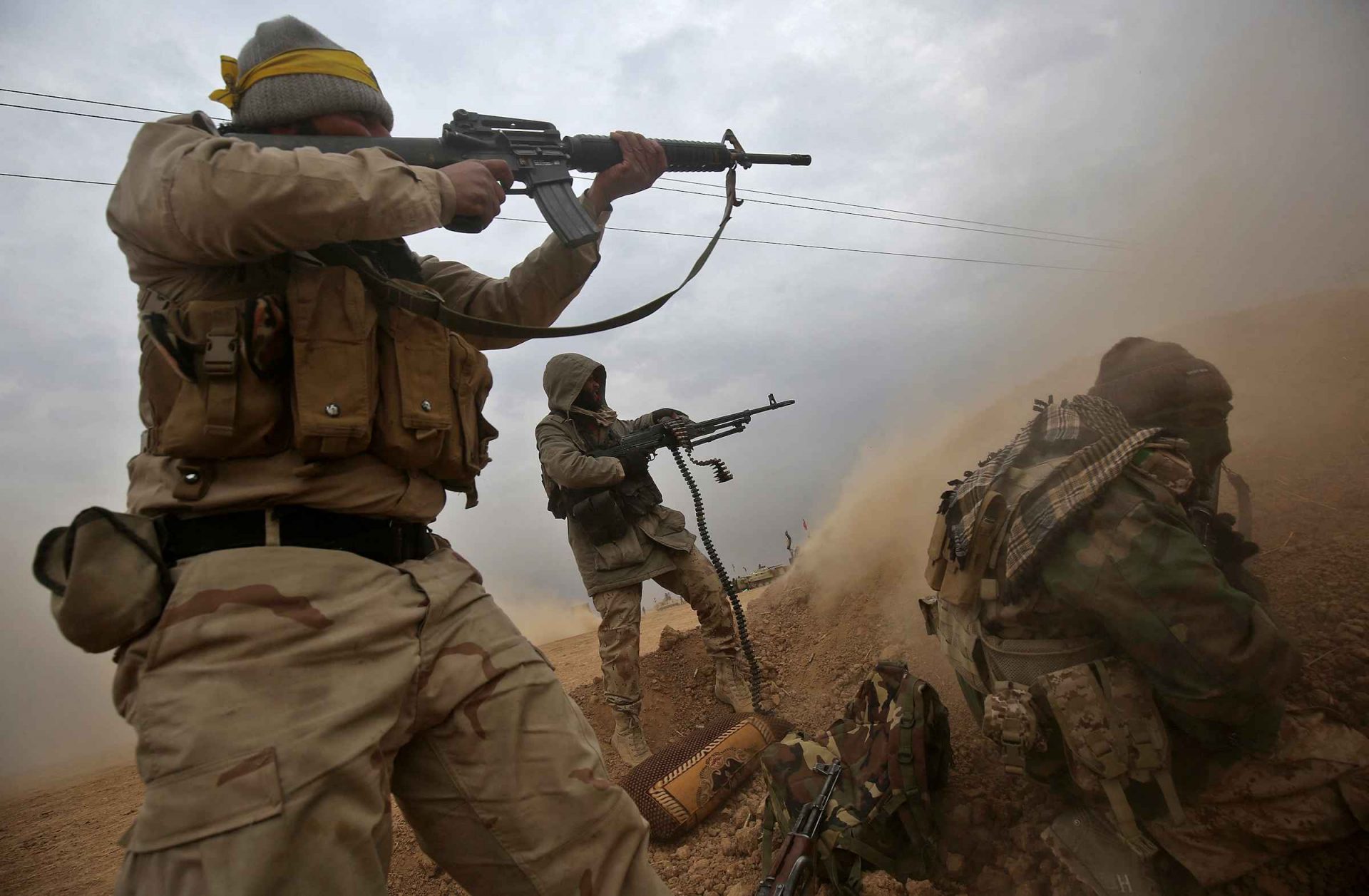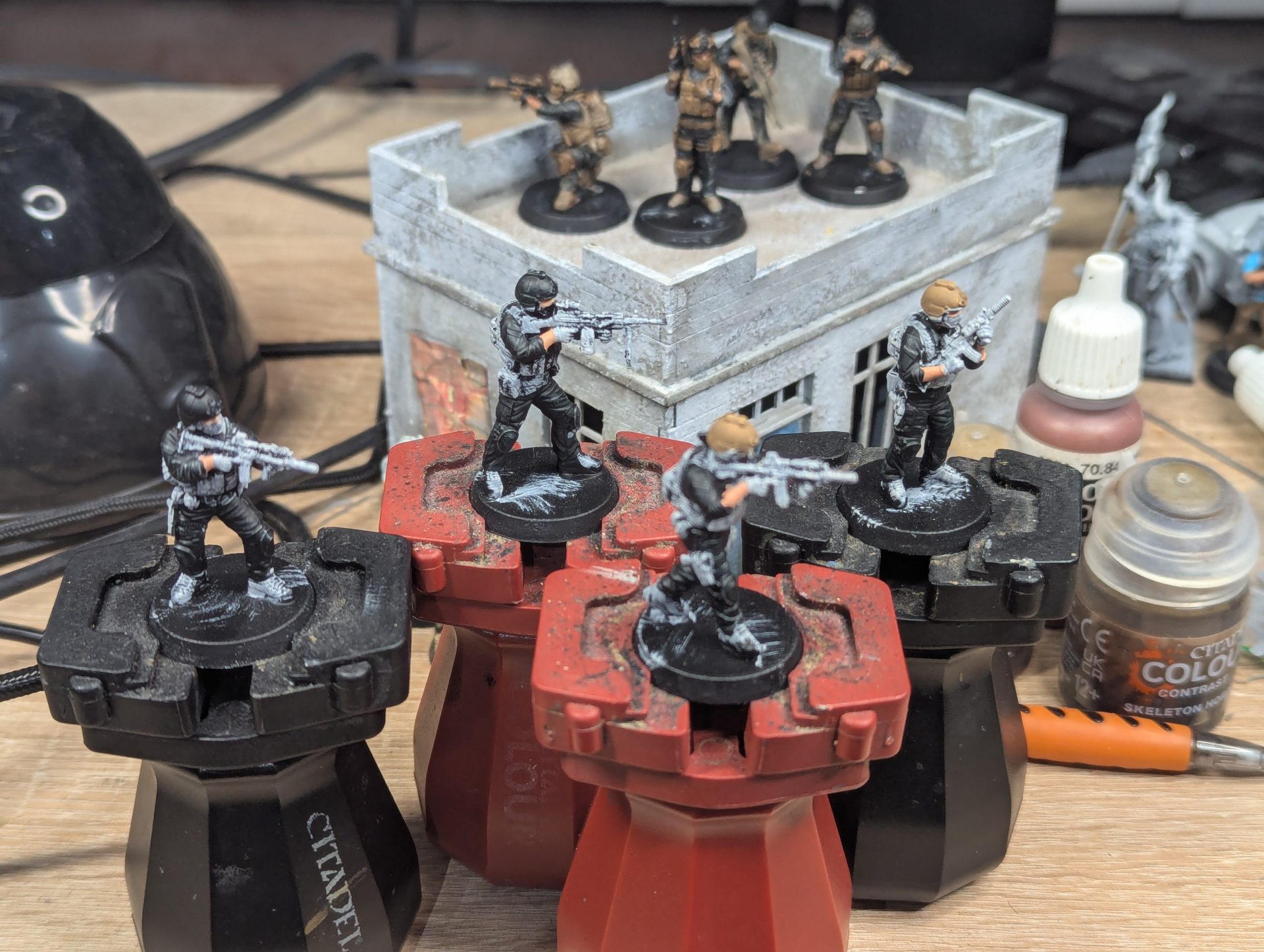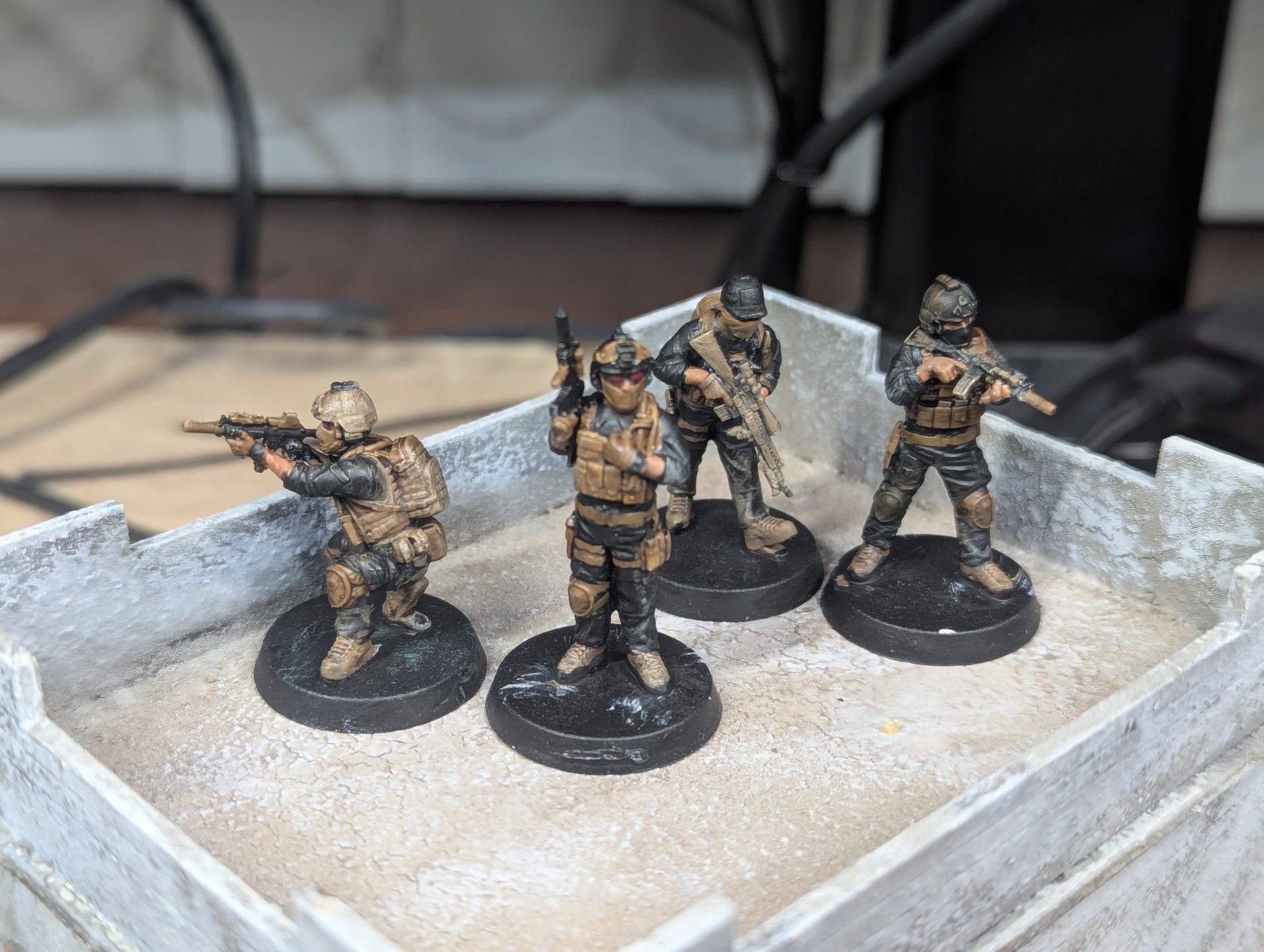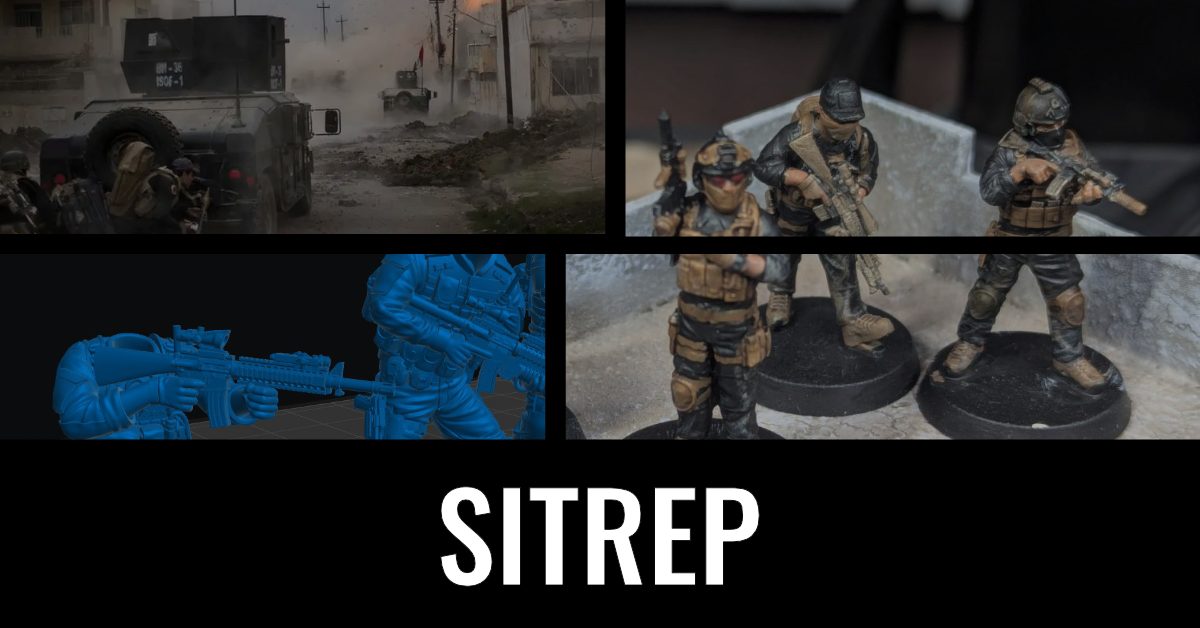With my refocusing on Ultamoderns, I’ve started to assemble the collection of figures, vehicles and scenery together for the theatre I’m working on. As much as I may attempt to leave the MENA style settings with Shyluz and such, there is so much material (inspiration, research, figures, vehicles and terrain) to fuel the ideas – Bazistan has been part of this blog’s DNA since it was a mere imagination in the real world. I am, however, keen to expand beyond playing the most common scenario – a horde of poorly trained insurgents vs a small number of highly trained, well-equipped and well-supported Western SOF. As much as this was definitely a situation that has occurred multiple times in modern warfare, it is only one of the possibilities that players can get on the tabletop.

Something I’ve always been especially interested in are the forces working alongside the Western units, partner forces from the region itself. The last 20+ years of conflict in the Middle East (and in other regions across the world) have seen Western (and in some cases Russian) special forces and regulars working alongside various levels of trained and motivated fighting forces. Some units gained a reputation for their failure to work as a fighting force (such as the Afghan National Police), while were of questionable allegiance (such as the Popular Mobilisation Units that notoriously received instruction from Iran while technically under the control of the Iraqi Government). However, for every suspect unit, there would be others that would become some incredibly hard fighters. Two group in particular that come to mind are the Triples in Afghanistan, which were trained by the British for counter-narcotics operations, and the Golden Division, key in the battle to reclaim Mosul, was formed out of the Iraqi Special Operations Forces, a unit that was stood up in 2005 for counter-terrorism with US assistance before having to expand for other more conventional warfighting roles. This doesn’t even begin to cover the group formed from governments in the region that major forces have found themselves working alongside, such as Jordanian Special Forces or the Armed Forces of the Philippines in the Battle of Marawi.

All of these forces are interesting for an ultramodern wargame. From the point of view of someone exploring the history, partner forces became an incredibly important part of the GWOT in the later stages. With both Afghanistan and Iraq seeing gradual drawdowns of conventional forces (through processes such as Afghanization), these were periods where operations were shifted from being purely Western with limited local support to locally led but with Western enablers to cover gaps that local forces were yet to develop (such as medical evacuation or fire support). The war against Daesh took this to another level, with Western support being mostly limited to Special Forces, advisors and airpower. To understand the era, it’s worth attempting to play scenarios with this adjustment.
On the tabletop, they also present a challenge. Partner forces can share equipment (or be armed more closely to the opposition) but there are other factors that shift how they should play out. In general, these units are utilising lower quality equipment and fewer force multipliers (functional optics, night vision and body armour) and are more commonly less skilled. They will commonly lack the support that most Western forces rely on, such as heavy strike aircraft or a rapid ISTAR system that can keep the troops on the ground aware of their current situation. Even if they have weapon systems such as the armoured vehicles, they will often be less well equipped than Western counterparts, such as the Iraqi units in the war against Daesh using the M1A1 Abrams rather than the M1A2 in its various upgraded forms that was in service with the Americans.

This may seem purely like a bad deal, especially having less toys to play. However, there are other factors when wargaming that can make partner forces interesting to play. For a start, these units are often deployed in larger numbers than their western counterparts, especially when using the more milita/paramilitary units. I don’t like to talk too much about point values, but seeing as partner forces are lower skill and less well-equipped than the more usual forces, you should be able to get more of them for your buck. You can also get your hands on various equipment not used by more traditional forces. Technicals, improvised and up-armoured patterns of older equipment, many of the toys that you might see in Milita forces find themselves being used by western-aligned paramilitaries. In some cases, partner forces might receive specific equipment for their need, such as the M1117 (an armoured vehicle used in the US as a Military Police vehicle but more commonly seen as a frontline vehicle in Iraq). If you really need to include some operators, then Partner Forces would often work with Special Forces attached – United States Army Special Forces are explicitly designed for this task as part of their “Foreign internal defence”, but MARSOC and other teams have seen themselves working alongside local elements. As well as the highly trained individuals, their presence can also allow for additional lethal and non-lethal support, and can also lead to mentoring bonuses depending on the ruleset.
However, what I think is more interesting is the difference in attitudes. Western forces have to worry about more than purely fulfilling the objective, with both the political and media landscape at home needing to be taken into account – every casualty has the chance to massively affect the situation in the long term, be it for a soldier returning home differently to how they left or for imagery of civilian casulities appear on the front of newspapers and shifting opinions on a conflict. Partner forces, in most cases, do not care about this. In most cases, there is a very limited need to keep the general public happy (which can be for both positive and negative reasons), leading to them being much more likely to utilise every tool in their arsenal. If we look at the Battle of Mosul in 2016, that was not the usual counter-insurgency but a full-scale war, with massive casualties on both sides and the usage of fire support to reduce the city to rubble in the process of reclaiming it. When building scenarios to accommodate using Partner Forces, players should be punished far less for taking casualties or collateral damage. Similarly, what many of these forces lack in skill, they can (and I swear the word “can” is doing a lot of hard work here) be far more motivated to do whatever is needed to achieve victory – these forces are fighting over their own land in many cases, which can often affect the motivation. Now, this doesn’t mean every force is a fanatical group of killers (many are noted for shirking their duties), but this variety of motivation can lead to some interesting scenarios.
With that setup, how am I implementing them in my current wargaming plan? Well, the initial theatre I’m working on is Parezgehan, a region sat between the Albion Commonwealth and the bulk of the Bazi Empire. Although ostensibly aligned with the Empire, the Princedom of Parezgehan (split between the various scions of the Parez lineage) has been double-dipping, taking advantage of the unusual structure of the Empire (not to mention its current level of infighting and problems elsewhere on its borders with the Tsardom) to also talk extensively with the Albion Commonwealth and enter into a deeper level of co-operation with them. This has included bringing in the Albion Commonwealth to train up forces specific to the Princedom, with capabilities ranging from high-end special forces to armed units reporting directly to the Princedom, down to establishing a framework for self-defence militias.
With this setup in mind, this gives us three levels of local forces to work alongside Albion SOF and Regular troops (which will be predominantly pulled from Spectre’s SAS and British Infantry). At the highest level, we have the newly formed Regional Security Echelon (RSE), intended for Counter-Terrorism and internal security forces – these guys are inspired by the Iraqi CTS-ISOF, even down to their paint scheme. The Parez Guard will function as an expansion of the Princedom’s household guard, adjusting them from merely protecting the royal palace into a more general self-defence force – publicly they are to assist the Bazi Imperial Defence Corps (BIDC) with tasks but in reality, the Parez Guard are moving to take responsibility for more key locations, negotiating to take control of more military installations. Finally, the Parez Militia is a self-defence milita, raised by important personalities within the region in times of emergency before being put under the control of the Guard or the . Of course, preparing large groups of armed fighters within a nation planning to break away from an Empire and under the control of specific individuals may be the setup for some… unforeseen consequences.

For the Special Forces, I’ve printed off some of Combat Octopus’s Navy SEALs from roughly 2007. The advantage of these figures is that they look reasonably high speed without matching the vast array of Crye Precision and Fast Helmet wearing operators we all love to collect. My main goal for these guys is to keep them mostly consistent, sticking with US-style platforms and utilising a common colour scheme for BDUs and web gear (although elements such as helmets, kneepads and boots can be slightly different to show personal purchases). The intention is to outfit them in fireteam organisation, with groups of four soldiers including at least an MG and ideally with a grenade launcher as well. The two Navy SEAL kits include a mixture of weapons, with a selection of M4s, M16s and MK18s accompanied by SR-25s as marksmen rifles and Mk48 machine guns. Each weapon system has multiple poses for it, meaning you can mix and match setups to make a variety of figures (something then enhanced by the addition of the piles of pouches Combat Octopus has released). The only comment I’d maybe make is the lack of 40mm grenade launchers – one of the loaded bodies comes with a slung M79 while a teammate carries his ammo. Although this setup is suitable for a light recce squad, it does limit options when kitbashing. Luckily there is a holstered M320 elswhere in the Combat Octopus range that can be mounted to gear or I can digitally kitbash the M4 with M203 from the US Army release (but more on that later).
To begin with, I simply grabbed the non-modular figures from the releases. I’ve spoken in the past about my feelings on these additions to the last few Combat Octopus releases, as they are a net positive to those purchasing these sets. It allows anyone who just wants to print the figures to get the best version, getting you through the door without having to sit down and customise each figure (especially on figures with molle panels that need the pouches placing. In my case, I just wanted to get them printed as test core to the force, figures that I just had to scale up to my chosen scale before hitting print. For heads, I went for a feature you commonly see among Iraqi CTS units – face coverings to hide their identity. This is a distinctive look (and saves me painting faces) so naturally I grabbed two of the heads from the SEAL releases and a baseball cap head from the September 2023 PMC release and got to printing. I went heavy on the more plain of the helmets, leaving the stacked “goggles + shades” head as a unique one for the squad leader.

For the paint scheme, I leaned heavily on the Iraqi CTS scheme – black BDUs and tan webbing. This is easy to paint up, especially using Black Templar contrast over the black spray/drybrush white basecoat. This was then combined with a Valejo US Field Drab for the tan parts, such as shoes, kneepads and helmets. While attempting to keep them pretty uniform, there are definitely places to add a little personality – I’m planning to subtly tweak each of the helmets, using the base colours tan and black before drybrushing more camo on.

After doing these first eight, I will definitely get another set printed with some more custom setups. I’ll definitely need at least one more machine gunner (although more likely another three of them to allow for four fireteams), as well as a few more marksmen and grenade launchers. I also want to use some of the M16s and M4s to really sell the mixed quality of these guys, as you can see in my first test guys above. I do need to do a few tweaks to make the bodies line up a little better, as well as add on extra pouches for all the gear they may need. Luckily, my collection has a vast number of pouches I can reach into, as well as a few slung weapons for extra firepower.

I’ve also broken out of just the Navy SEALs set to look at what else Combat Octopus has. These three guys will end up being part of the Parez Milita, showing how some of the high-end gear ends up finding itself in the hands of the less well-trained troopers. The first figure uses the legs from the US Army Infantry set combined with the torso and rifle from the Navy SEALs. The second is a little more involved, tweaking the unusual cut of the US Army set to fit better on the US Navy SEALs legs. Finally, the last guy mixes the US Navy SEALs torso and gun with the legs of the new MENA Freedom Fighters set, ideal for that rough and ready look. These are only the first guys, but I’ll definitely be delving into more of the Combat Octopus range – not every pack goes with every other release, but there is usually plenty of crossover to really combine and create. The fact that we’re seeing two more Freedom Fighter releases should extend the collection even further. I’m also intrigued to do some more aggressive tweaks, such as combining the PASGAT helmet from the Indian release (back in November 2021) with the recent head sculpts.
This is a bit of a first glance into what I’ve been up to in my hobby time, as well as my return to Ultramoderns. Hopefully, this has been an interesting read, and hopefully sets off some ideas for you as well. For now though, I need to go assemble some more figures for The Parez Guard – bulky body armour and assault rifles will be the name of the game, now to decide who for…



Leave a Reply